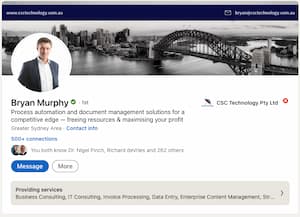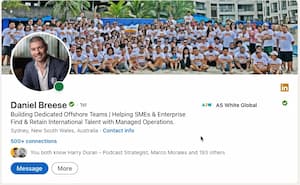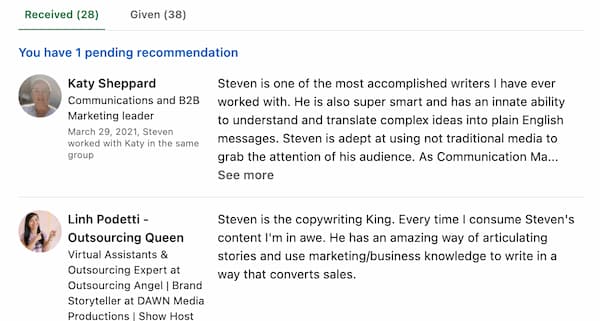How to write a great LinkedIn profile
Wondering how to write a LinkedIn profile? You should know that what makes a great LinkedIn profile is different from what makes a great resume or CV. Recruiters use LinkedIn, but LinkedIn is more than a repository of resumes: LinkedIn is a powerful networking tool. A great LinkedIn profile can help you develop relationships with clients, co-workers and potential employers.

Creating a LinkedIn profile is just one aspect of succeeding on LinkedIn. It’s important to be thinking of making connections with other LinkedIn users. Better connections mean your profile will be noticed by people who matter.
Your LinkedIn profile is more important than ever today. That’s because LinkedIn is so common now that employers and clients expect you to have a profile. As a result, you’re going to have to work harder if you don’t have a LinkedIn profile.
If you don’t have a profile in business or during a job search, you’re raising questions about yourself. Why doesn’t this person have a profile? Are they hiding something? Are they genuine?
[toc]
The purpose of a LinkedIn profile
The purpose of a LinkedIn profile is to help others to recognise you as the person they need. And your profile does that without you having to make the first move. People can find you and learn this about you without having to seek them out to tell them.
This is especially handy if you’re a job seeker because many jobs aren’t advertised. Many jobs filled before they’re announced by recruiters and employers searching LinkedIn.
This means it’s worth spending some time to get your profile set up and looking good. You want others to know who you are. You want them to know what skills and strengths you bring to the table.
Your LinkedIn profile makes you easy to find and easy to contact in the right circles, building your professional profile. (That is, as long as you put the profile together in a way that helps you to be found.)
How will a LinkedIn profile help me in my business or career?
LinkedIn for business owners

A LinkedIn profile will help you in your business by establishing you as an expert in your field. With a good profile, it’s easy for the right people to find out about your background, education, and experience by searching through the information on your profile.
You also have the opportunity to introduce them to who you are as a person, especially through LinkedIn’s About (summary) section. In a world where people care deeply about aligned values, there’s a good chance your ideal contacts do want to know your “why”. Connecting with people is easier when they can see who you are.
LinkedIn for employees
A LinkedIn profile will help you in your career by providing a great first impression to potential employers and recruiters. They can also use your profile as an introduction to you, building their confidence in hiring you for the job.
One of the most important keys to building and maintaining relationships with a prospective employer is being viewed as trustworthy. An established and mature profile helps to build that trust with a hiring manager because it’s hard for job candidates to fake that level of detail.
What makes a LinkedIn profile “professional”
A LinkedIn profile is professional when it’s accurate and contains all the right information. There are a few things that can make a LinkedIn profile look unprofessional:
- Having no photo on your profile
- Not using spellcheck or proper grammar in your writing
- Not updating your public profile to match your private one
Looking professional on LinkedIn isn’t about sounding stiff in your LinkedIn profile. LinkedIn isn’t TikTok or Instagram; it’s not “Facebook for business”. However, it is a social network that rewards people who participate. For a start, don’t talk about yourself in the third person — It’s “I worked…” not “Steven worked…”
Your LinkedIn profile should include (at the very least) a professional photo of yourself (a headshot is most appropriate), your current position, your work experience, where you attended college or university, what languages you speak, and any volunteer experience. The more you include, the more rounded and valuable you appear.
A good LinkedIn profile will also have the following sections:
- The About (LinkedIn profile summary) section. This section is a chance for you to address the reader and explain how you got here.
- Work Experience section: This can be used for both paid and unpaid positions
- Education section: Include where you went to school and what degree(s) you received
- Projects section: Add any projects that are relevant to your background. You can even use this section to showcase a blog.
In most of the important sections, you have up to 2,000 characters (about 250 words), so there’s plenty of space for detail and keywords. (See below for more on keywords.) Feel free to use bullet points if it makes your profile easier to read.
When it comes to what should be on a LinkedIn profile, trust LinkedIn itself. If LinkedIn has bothered to create a section for your profile, you should probably bother to fill it in. This includes contact details — use a real email address, not your Hotmail address from university.
For more on fixing up your profile, read 7 Simple LinkedIn Mistakes (And How To Fix Them).
Are you making these LinkedIn profile mistakes?
Rearranging the sections on your LinkedIn profile
You can’t rearrange the sections in your LinkedIn profile. That makes sense from LinkedIn’s point of view — they want to make it easy for people to find things, which is facilitated by everything being in the same place on everyone’s profile.
What are LinkedIn Endorsements?

LinkedIn endorsements are a way for people to show their support and trust in your professional abilities. Truth be told, however, endorsements are easy to make — LinkedIn often asks a user to click the skills they think the profile holder has. It doesn’t matter that the person being asked has no way to know that you have that skill. For that reason, endorsements are likely not valued much by LinkedIn or by readers of your profile.
What is a LinkedIn recommendation?

A LinkedIn recommendation is like a reference or a testimonial. They are harder to come by because they require more of the author than a click. The author has to take the time to write something, and they want it to look good because it will be shown on your profile against their name.
For that reason, recommendations are valuable additions to your profile and you should make an effort to seek them out. We also have advice on how to write a LinkedIn recommendation.
How should my LinkedIn profile differ from my resume?
Your LinkedIn profile should differ from your resume by being more personal and more complete. Your resume should be a summary of your professional accomplishments – but it doesn’t need to have a photo or much detail about who you are as a person. That’s what the LinkedIn profile is for.
Five fast ways to improve your LinkedIn profile
To summarise the above, these are five fast ways that would improve many LinkedIn profiles:
- A better profile picture
- More complete information
- Making sure what’s on your LinkedIn profile is consistent with what’s known about you elsewhere
- Optimising specific sections in LinkedIn such as skills, work experience, education to showcase things that matter to the people you care about
- Adding keywords (see below)
Going beyond your profile
If you’re not newly emerged in the world of business or employment, you know people and they’re on LinkedIn. LinkedIn gives users the ability to reach out to past and present colleagues, industry peers, and potential employers. By tapping into that network, you can be connected to opportunities as they emerge and before other people can seize them.
How to optimise your LinkedIn profile
If you want a head start on the competition, it’s important to optimise your LinkedIn profile. This will definitely help if you want to be noticed by recruiters who are looking for potential candidates — 94% of them use LinkedIn as a go-to resource. You want the right people to find your profile.
However, whether you’re using LinkedIn to find your next job or to develop your business, the best LinkedIn profile is the one that can be found by the right people. If you want that to be your profile, you need to optimise your profile to be found easily when your target audience is searching. That means you need to invest time adding keywords, which goes hand in hand with fleshing out your profile to include more detail about you. (As you add more detail, you add more keywords.)
Keywords are the words used in a search, e.g. “project manager”, “CFO”, “Excel skills”, etc.
Add keywords to your LinkedIn profile
To increase your chances of being a top result in a recruiter’s LinkedIn search, your hard skills and keywords should be placed into the fields LinkedIn’s search algorithm values the most. These include:
- Headline
- Past and present job titles
- Profile Summary or About section
- Work experience
- Keywords in the Skills and Endorsements section will also be used in LinkedIn’s search engine, but they’re not as heavily weighted
Overall, the more relevant keywords you have in your profile, the more likely you are to be found when users are making the kind of search that you want to be found in.
To add relevant keywords throughout your profile, you should think about what you would type into the search box of LinkedIn if you were looking for someone like you. What sort of terms would be in a recruiter’s job description for the job you do? Make sure those terms are used throughout your profile, especially in the areas listed above.
How to build your network (and get market intelligence) by reaching out to potential connections on LinkedIn
You can reach out to connections on LinkedIn by either sending a connection request or leaving a comment and hoping for a response. You can also use LinkedIn to get updates on people who aren’t your connections by going through the directory of people at particular companies.
LinkedIn has many more benefits to offer than finding new jobs or keeping in touch with colleagues. Every day, millions of business owners generate sales leads, forge partnerships and further establish themselves as thought leaders by using LinkedIn’s free features.
The more people you connect with on LinkedIn, the better your networking strategy. Think professionally but widely and include
- Friends and acquaintances
- Colleagues (past and present)
- Suppliers
- Other business contacts
- Industry peers (even if you haven’t met them yet)
- Big names (everyone loves to be connected, so aim high)
Building a large network on LinkedIn will allow you to contact more people through the site. Every new connection is labelled as a first-degree connection. That gives you access to some of their connections, too. That’s the benefit of thinking widely about who to connect with.
More pro tips for a killer LinkedIn profile
1. Create a Vanity URL
By default, your LinkedIn profile’s URL is your name followed by a series of numbers. This configuration can make sharing the link difficult — it’s long and ugly. You can create and customise your link from the settings section of your LinkedIn account.
A customised URL is easier to remember and share with others
2. Consistently share content
Posting links to relevant blog posts and interesting updates is a good way to increase your credibility in LinkedIn.
Your posts won’t go to everyone you’re connected to. LinkedIn automatically filters which posts go into a person’s newsfeed depending on how good the post is deemed by their algorithm; only quality updates are then shared among connections in close proximity to keep people engaged. The more clicks, likes, or comments an update gets, the higher chance there’ll be for them spreading farther throughout the entire social media site.
3. Work LinkedIn’s algorithm
Your posts won’t automatically go out to all of your connections. When you publish an update, LinkedIn’s newsfeed algorithm judges your post to determine whether it is quality content or spam. If it passes, your post then gets shared with a small segment of your connections.
Whether or not your LinkedIn post spreads to a bigger audience is based on engagement. The more clicks, likes, and comments your post gets, the more 1st and 2nd-degree connections it will reach. With this in mind, always be sure that the content you’re sharing is genuinely useful to your connections.
You can also drive engagement by asking questions and creating a conversation in the comments section.
Take our online course on writing a winning LinkedIn profile
Your LinkedIn profile can make or break your ability to attract the right connections. Taleist has a LinkedIn profile writing service, but our professional LinkedIn profile writers have made it easier for you to have a winning LinkedIn profile by putting everything they know into this online LinkedIn profile writing course.
Free guide to writing a LinkedIn profile
Also, you might be interested in our guide to Simple LinkedIn Profile Mistakes (And How To Fix Them).